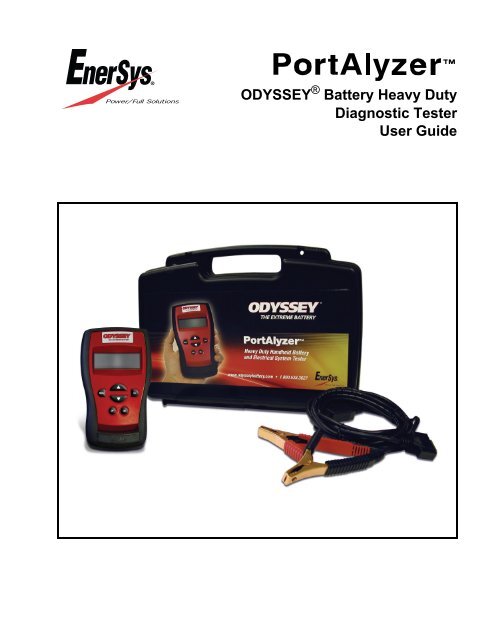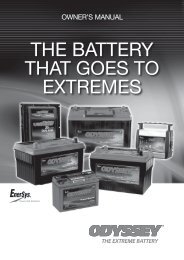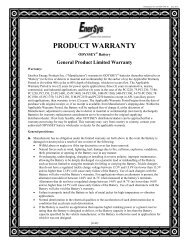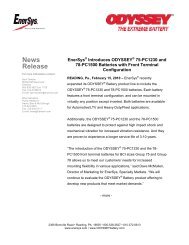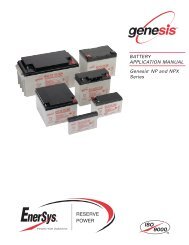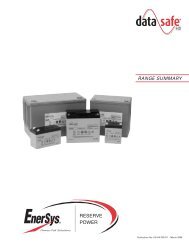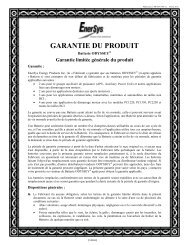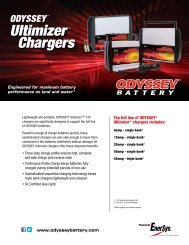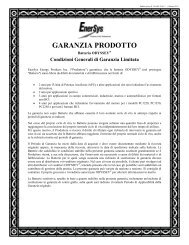PortAlyzer⢠Tester Manual - ODYSSEY Batteries
PortAlyzer⢠Tester Manual - ODYSSEY Batteries
PortAlyzer⢠Tester Manual - ODYSSEY Batteries
You also want an ePaper? Increase the reach of your titles
YUMPU automatically turns print PDFs into web optimized ePapers that Google loves.
<strong>ODYSSEY</strong> ® Battery Heavy DutyDiagnostic <strong>Tester</strong>User Guide
IMPORTANT NOTICESSAFETYAll DANGER, WARNING, IMPORTANT messages and Notes must be followed for your safety. These safetymessages are in the following formats:DANGER: Means you may risk possible loss of lifeWARNING: Means you may risk possible bodily harmIMPORTANT: Means you risk damage to the vehicle or the toolNotes: are added to provide clarity and helpful tipsThese safety messages cover situations of which the manufacturer of the <strong>ODYSSEY</strong> ® Heavy Duty BatteryDiagnostic <strong>Tester</strong> is aware. The manufacturer cannot know, evaluate and advise you as to all of the possiblehazards. You must be certain that any conditions or service procedures encountered do not jeopardize yourpersonal safety.COPYRIGHTNo part of this manual may be reproduced, stored in a retrieval system or transmitted, in any form or by anymeans, electronic, mechanical, photocopying, recording, or otherwise, without the prior written permissionof EnerSys ® .DISCLAIMERAll information, illustrations and specifications contained in this technical instruction manual are based on thelatest information available at the time of publication. The right is reserved to make changes at any time withoutobligation to notify any person or organization of such revisions or changes. Further, EnerSys ® shall not be liablefor errors contained herein or for incidental or consequential damages (including lost profits) in connection withthe furnishing, performance or use of this material.© 2008 EnerSys. All rights reserved.
ContentsChapter 1: General Information . . . . . . . . . . . . . . . . . . . . . . . . . . 1Component Identification . . . . . . . . . . . . . . . . . . . . . . . . . . . . . . . . . . . . . . . .1PortAlyzer Heavy Duty <strong>Tester</strong> . . . . . . . . . . . . . . . . . . . . . . . . . . . . . . . .1Test Lead with Battery Clamps . . . . . . . . . . . . . . . . . . . . . . . . . . . . . . . . .1Chapter 2: <strong>ODYSSEY</strong> ® Battery Tests . . . . . . . . . . . . . . . . . . . . . . 3Pretest Steps. . . . . . . . . . . . . . . . . . . . . . . . . . . . . . . . . . . . . . . . . . . . . . . . . .3EnerSys ® <strong>Batteries</strong> and Functions . . . . . . . . . . . . . . . . . . . . . . . . . . . . . . . . .3Chapter 3: Non-<strong>ODYSSEY</strong> ® Battery Tests. . . . . . . . . . . . . . . . . . 5Pretest Steps. . . . . . . . . . . . . . . . . . . . . . . . . . . . . . . . . . . . . . . . . . . . . . . . . .5Other <strong>Batteries</strong> and Functions (non-<strong>ODYSSEY</strong> ® batteries) . . . . . . . . . . . . . .6IN VEHICLE Battery and Electrical System Test (non-<strong>ODYSSEY</strong> ® batteries) 6OUT OF VEHICLE Battery Test . . . . . . . . . . . . . . . . . . . . . . . . . . . . . . . . . . .9QUICK TEST (Battery) . . . . . . . . . . . . . . . . . . . . . . . . . . . . . . . . . . . . . . . . .10Understanding Test Results . . . . . . . . . . . . . . . . . . . . . . . . . . . . . . . . . . . . . 11Battery Test Results . . . . . . . . . . . . . . . . . . . . . . . . . . . . . . . . . . . . . . . . 11System Test Results . . . . . . . . . . . . . . . . . . . . . . . . . . . . . . . . . . . . . . . . 11Chapter 4: More Functions Menu . . . . . . . . . . . . . . . . . . . . . . . . 13VIEW LAST TEST Results . . . . . . . . . . . . . . . . . . . . . . . . . . . . . . . . . . . . . .13SOFTWARE UPDATE. . . . . . . . . . . . . . . . . . . . . . . . . . . . . . . . . . . . . . . . . .14UNIT VERSION. . . . . . . . . . . . . . . . . . . . . . . . . . . . . . . . . . . . . . . . . . . . . . .14TEST COUNTERS . . . . . . . . . . . . . . . . . . . . . . . . . . . . . . . . . . . . . . . . . . . .14STORED TESTS. . . . . . . . . . . . . . . . . . . . . . . . . . . . . . . . . . . . . . . . . . . . . .15MANUAL CRANK DATA . . . . . . . . . . . . . . . . . . . . . . . . . . . . . . . . . . . . . . . .15ACC LOAD TEST . . . . . . . . . . . . . . . . . . . . . . . . . . . . . . . . . . . . . . . . . . . . .16
PortAlyzer Battery <strong>Tester</strong> User GuideSafety PrecautionsiSafety PrecautionsDANGER:• When an engine is operating, keep the service area WELL VENTILATED or attach a buildingexhaust removal system to the engine exhaust system. Engines produce carbon monoxide,an odorless, poisonous gas that causes slower reaction time and can lead to serious injuryor death.WARNING:• Wear an American National Standards Institute (ANSI) approved eye shield when testing orrepairing vehicles. Objects propelled by whirling engine components or pressurized liquidsescaping may cause personal injury.• Set the parking brake and block the wheels before testing or repairing a vehicle. It is especiallyimportant to block the wheels on front-wheel drive vehicles because the parking brake doesnot hold the drive wheels.• Do not drive the vehicle and operate the tester at the same time. Any distractions maycause an accident. Have one person operate the tester as another person drives the vehicle.• Maintain adequate clearance around moving components or belts during testing. Movingcomponents and belts can catch loose clothing, body parts or test equipment and causeserious damage or personal injury.• Automotive batteries contain sulfuric acid and produce explosive gases that can result in seriousinjury. Stand back from the battery during testing. To prevent ignition of gases, keep lightedcigarettes, sparks, flames and other ignition sources away from the battery at all times.• Do not test a frozen battery, as it may explode. Allow the battery to warm up before testing.• Do not spray liquids on the tester. Liquids may enter the tester and cause permanent damageto the electrical components. Flammable liquids may cause an explosion.• Do not use the test leads if the insulation is damaged or if metal is exposed.• Do not remove the test leads while a test is running.• Do not touch the test leads, tips or the circuit being tested.• Refer to the service manual for the vehicle being serviced and adhere to all diagnosticprocedures and precautions.IMPORTANT:To prevent damage to the vehicle computer when disconnecting battery cables:• Turn the ignition and all accessories and loads off. Close the vehicle doors and trunk lid.• Remove the negative battery cable first, then remove the positive cable.
This page is intentionally blank
2 This page is intentionally blank
4 This page is intentionally blank
PortAlyzer Battery <strong>Tester</strong> User GuideChapter 3: Non-<strong>ODYSSEY</strong> ® Battery TestsOverview53: Non-<strong>ODYSSEY</strong> ® Battery TestsOverviewThe PortAlyzer Heavy Duty Battery <strong>Tester</strong> reports thebattery condition of <strong>ODYSSEY</strong> ® and non-<strong>ODYSSEY</strong> 6 / 12 /24 volt batteries and the vehicle starting / charging system.The test results include the battery condition, the vehicle’scharging and starting system and diodes.IN VEHICLE: tests <strong>ODYSSEY</strong> 12 volt batteries or a non-<strong>ODYSSEY</strong> 6, 12 or 24 volt system that is installed in a vehicle.The non-<strong>ODYSSEY</strong> test determines the battery conditionsand then lets you continue with a test of the vehicle’sstarting/charging system. The test results include the batterycondition and the condition of the vehicle’s charging system,starting system and diodes. For instructions, refer to page 6.OUT OF VEHICLE: tests a <strong>ODYSSEY</strong> 12 volt battery or anon-<strong>ODYSSEY</strong> 6 or 12 volt battery. This test determines thebattery condition and displays the results (good, bad, etc.)along with the battery’s open circuit voltage (OCV). Forinstructions, refer to page 9.QUICK TEST: determines the condition of a <strong>ODYSSEY</strong> 12volt battery or a non-<strong>ODYSSEY</strong> 6, 12 or 24 volt battery orbattery pack. The Quick Test displays the Open CircuitVoltage (OCV), Cold Cranking Amps (CCA), Cranking Amps(CA), Ampere Hours (A-HR), and German-Duetche IndustryNorm (DIN) as applicable. For instructions, refer to page 10.More Functions: has the following options:• View Last Test - displays the results of the last testperformed.• Set Time / Date - lets you set a date and time for printingon test results.• Software Update - updates the software when properlyconnected to a PC.• Unit Version - displays information about the software,such as name, version number, etc.• Test Counters - displays the number of tests done with thetester and lets you reset the counters to zero.• Stored Tests - stores the results for up to 13 tests for youto review later.• <strong>Manual</strong> Crank Data - displays live amps, maximum amps,live volts and minimum volts during engine cranking.• Acc. Load Test - checks the capacity of the alternator atidle with accessory loads applied.For instructions, refer to page 13.Pretest StepsTo prepare for testing, follow these steps:1 Check the following:• WARNING: When connecting and disconnectingfrom the positive terminal, be careful of battery holddowns. Major arcing will occur if your positiveclamp simultaneously contacts both the positiveterminal and battery hold down.• If the battery being tested is frozen, let it warm upbefore testing.• Make sure that the terminals of the battery beingtested are clean and dry; clean with a wire brush ifnecessary.• If the battery being tested was recently charged or used(is in a vehicle that had the engine running), let thebattery stabilize 3 minutes before testing. Otherwise,let the battery stabilize 1 minute before testing.• If testing a battery installed in a vehicle, make surethe contact between the battery terminals andcables is not oxidized or loose, which causescranking and charging problems and may falsifythe test results.• If testing a battery installed in a vehicle, turn off allsources that may drain current from the battery.For example, turn the vehicle’s ignition key and allaccessories and other loads off, close the doorsand trunk, and disconnect the under-hood light.2 Install a 9 volt battery in the battery tester’s batterycompartment. (To open the compartment, slide the covertoward the bottom of the tester.)Note: Replace the internal 9 volt battery if the PortAlyzerBattery <strong>Tester</strong> does not power up with it’s own battery or whenconnected to the battery to be tested.Note: Replace the internal 9 volt battery if the PortAlyzerBattery <strong>Tester</strong> returns to the Main Menu screen during a test.3 Connect the test lead (the one with the battery clamps)to the test lead port on the top of the tester. Finger-tightenthe connector’s screws.4 Attach the test lead’s clamps to the battery’s terminals:red to positive (+); black to negative (-).Note: The battery tester turns on automatically whenproperly connected to the battery. If it does not turn on, checkthe connections. Both clamps must make a solid contact withthe terminals.
PortAlyzer Battery <strong>Tester</strong> User GuideChapter 3: Non-<strong>ODYSSEY</strong> ® Battery TestsIN VEHICLE Battery and Electrical System Test (non-<strong>ODYSSEY</strong> ® batteries)75 Use the Down Arrow key to select the correct number(s)and type(s) of batteries, then press the GO key. Thisdisplays the Select Battery Type screen.Select Battery TypeCONVENTIONAL GOAGM/GELL Change Batt. Type6 Do one of the following:• If the battery is conventional (flooded lead acid),press the GO key.• If the battery is AGM or GELL, press the DownArrow key, then press the GO key.7 Press the GO key. This displays the Select Units screen.SELECT UNITSCCA GO A-HRCA/MCADINChange JIS8 Use the Down Arrow key to select a capacity rating for thetest. The GO indicates the selected line.Note: This is the battery’s capacity rating that is usuallyfound on the battery’s label. Depending on the battery, useany of the following:• CCA - Cold Cranking Ampere rating• CA / MCA - Cranking Ampere / Marine CrankingAmpere rating• A-HR - Ampere Hours• DIN - German-Duetche Industry Norm• JIS - Japanese Industrial Standard9 After selecting a capacity rating, press the GO key.This displays a screen for entering the capacity rating.Enter Rated CCA ForOne Batt. 700 GO12Press GO. The battery pack test is performed. If the packis good, go to step 13.Note: If the battery pack is determined to be low, the screenpictured below will be displayed and the battery tester willbegin the Quick Idle test. Follow the on-screen prompts tocomplete the Quick Idle test.START THE ENGINERUN AT IDLE SPEEDGO = CONTINUE= NO STARTNote: If the engine does not start, press the Up Arrow key.The battery tester will proceed to the individual battery tests.13Wait for the screen to display “Is this an AIR-STARTvehicle?”IS THIS AN AIR-STARTVEHICLE?YES NO 14If you are testing an air-start vehicle, press the Up Arrowkey for “Yes”. If it is not an air-start vehicle, press the DownArrow key for “No”. The “start engine” screen is displayed.START VEHICLE ANDTURN OFF LOADSAC,R-DEFOG,ETC ‘GO’IF NO START ‘MENU’15Start the vehicle’s engine and then press the GO key. Thisstarts the test and displays the series of screens shown onthe next page.Note: If the engine does not start, press the MENU key.This displays the battery test results as described in step17 on page 8. Charge the battery(s) or use a boosterbattery to provide power.To Change ValueNote: If the battery pack you are testing is mismatched,disassemble the pack and test each battery individually.10Use the Up and Down Arrow keys and adjust the ratinguntil it matches the rating on the battery’s label.Note: Do not use the rating reported by the Quick Testbecause it is typically higher than the printed rating fora newer battery.11 Press the GO key. This displays the battery’s Open CircuitVoltage (OCV).PRESS GO 12.57V
8PortAlyzer Battery <strong>Tester</strong> User GuideIN VEHICLE Battery and Electrical System Test (non-<strong>ODYSSEY</strong> ® batteries)INCREASE IN RPMWILL BE REQUIREDPRESS GORUN ENGINE ABOVE1500 RPM NOW ANDMAINTAIN FOR 15SECONDSMAINTAIN SPEEDVOLTS = 14.70vWITH ENGINE IDLINGTURN ON ALL OF THEELECTRICAL ACC/LOADSPRESS GOTEST COMPLETETURN ENGINE OFF16Follow the instructions given on the screens to hold theengine RPM above 1500 for 15 seconds and then turn theengine off. The test results display immediately.OCV 12.57TESTED CCA 1122BATTERY GOODMORE GO - PrintNote: The test results appear on several screens.They may include special messages, readings, or conditionresults. To view each screen, use the Down Arrow key. Thefollowing steps are examples from a good battery andsystem. For test result descriptions, refer to “UnderstandingTest Results” on page 11.17If the battery and system test is good, the first screen oftest results displays the battery test results (shown above).These include battery condition, Open-circuit Voltage(OCV), and actual Cold Cranking Ampere rating (CCA).Press the Down Arrow key to display the next screen.Note: Other possible results for the first screen include NOSTART CONDITION, CHARGING VOLTS TOO LOW,BAT. GOOD/ LOW CHARGE, BAT. BAD, and BAT.CHARGE AND RETEST.CHG.LOAD V=13.73CHG.NO LOAD V=13.74CHG. VOLTS GOODMORE BACK GO-Print18The second screen of test results displays chargingsystem test results, which includes loaded and open-circuit(no load) voltages, and the test results for the chargingsystem. Press the Down Arrow key to display the nextscreen, or the Up Arrow to review the previous screen(s).Note: Possible charging system results are GOOD orCHARGING SYSTEM NEEDS REPAIR.DIODESMORE GOODBACK GO-Print19The third screen of test results displays the condition of thediodes. Press the Down Arrow key to display the nextscreen, or the Up Arrow to review the previous screen(s).Note: Possible diode results are GOOD, BAD or NA.ACC.LOAD V=14.21ACC. LOAD VOLTS GOODMORE BACK GO-Print20The fourth screen of test results displays the loadedsystem test results. Press the Down Arrow key to displaythe next screen, or the Up Arrow to review the previousscreen(s).Note: Possible Acc. Load results are GOOD or LOW.CRANKING V=10.84GOODBACK GO-Print21The final screen of test results displays the crankingvoltage (voltage during starting) and condition. You canuse the Up Arrow to review the previous screen(s), printthe test results or return to the main menu using thefollowing steps.Note: Possible cranking voltage results are GOOD or LOW.22To end the test and return to the main menu, press theMENU key.23Select another test or disconnect the clamps from thebattery.24Press the OFF key to turn the battery tester off. (Thebattery tester turns off automatically after a few minutes ofinactivity.)
PortAlyzer Battery <strong>Tester</strong> User GuideOUT OF VEHICLE Battery TestThe OUT OF VEHICLE test takes about 13 seconds todetermine if the battery is good, has a low charge or is bad.The test shows the battery condition even if the battery isdischarged down to 1 volt state of charge.To do the OUT OF VEHICLE test, follow these steps:1 Do the steps in “Overview”. This displays the main menuon the battery tester.IN VEHICLEOUT OF VEHICLEQUICK TESTMore FunctionsNote: The word GO indicates the selected item.2 Use the Up and Down Arrow keys to select OUT OFVEHICLE and then press the GO key. This displaysthe Choose Battery Type screen.3 Do one of the following: GOSelect Battery TypeCONVENTIONAL GOAGM/GELL Change Batt. Type• If the battery is conventional (flooded lead acid),press the GO key.• If the battery is AGM, GELL or OPTIMA, press theDown Arrow key, then press the GO key.This displays the battery’s open circuit voltage (OCV).PRESS ’GO’ 12.60vNote: If the battery tester senses abnormal conditions, suchas very low voltage, other screens may display. Respond toany questions as necessary.4 Press the GO key. This displays the Select Units screen.SELECT UNITSCCA GO A-HRCA/MCADINChange JIS5 Use the Down Arrow key to select a capacity rating for thetest. The GO indicate the selected line.Note: This is the battery’s capacity rating that is usuallyfound on the battery’s label. Depending on the battery, useany of the following:• CCA - Cold Cranking Ampere rating• CA / MCA - Cranking Ampere / Marine CrankingAmpere rating• A-HR - Ampere Hours• DIN - German-Duetche Industry norm• JIS - Japanese Industrial StandardChapter 3: Non-<strong>ODYSSEY</strong> ® Battery TestsOUT OF VEHICLE Battery TestThis displays a screen for entering the capacity rating.Enter Rated CCA ForOne Batt. 700 GOTo Change Value6 Use the Up and Down Arrow keys and adjust the ratinguntil it matches the rating on the battery’s label.Note: Do not use the rating reported by the Quick Testbecause it is typically higher than the printed rating for anewer battery.7 Press the GO key to begin the load and recovery partof the test. The screen displays First Load On, SecondLoad On, Recovery Period and then Working as itapplies two medium loads to the battery followed byrecovery periods and then determines the batterycondition.Note: If the battery tester senses abnormal conditions, suchas a cold battery, other screens may display. Respond to anyquestions as necessary.8 When the test is complete, the screen displays the batterycondition, the Open Circuit Voltage (OCV) and the ColdCranking Amps (CCA).BAT. GOODOCV. 12.5 CCA 709Print Results = GONote: For some capacity ratings, the A-HR readingappears instead of the CCA reading. For the JIS capacityrating, the JIS code displays.9 Analyze the test results. For descriptions of possible testresults, refer to “Understanding Test Results” onpage 11.10To end the test and return to the main menu, press theMENU key.11 Select another test or disconnect the clamps from thebattery. Press the OFF key to turn the battery tester off.(The battery tester turns off automatically after a fewminutes of inactivity.)9
10PortAlyzer Battery <strong>Tester</strong> User GuideQUICK TEST (Battery)QUICK TEST (Battery)The QUICK TEST is a 1 second test to determine the batteryvoltage and actual Cold Cranking Amperes (CCA), CrankingAmpere rating (CA), Ampere Hours (A-HR), and German-Deutche Industry Norm (DIN) if applicable.To do the QUICK TEST, follow these steps:1 Do the steps in “Overview”. This displays the main menuon the battery tester.IN VEHICLEOUT OF VEHICLEQUICK TESTMore Functions GOWarning: When connecting and disconnecting from thepositive terminal, be very careful of battery hold downs.Major arcing will occur if your positive clampsimultaneously contacts both the positive terminal andbattery hold down.Note: The word GO indicates the selected item.2 Use the Up and Down Arrow keys to select QUICK TESTand then press the GO key. This displaysthe Select Battery Type screen.7 When the test is complete, the screen displays the openCircuit Voltage (OCV) and the Cold Cranking Amps (CCA).OCV 12.54↓ CCA 6508 Repeatedly press the Down Arrow key to change thesecond line to Cranking Amps (CA), then Ampere Hours(AHR), German-Deutche Industry Norm (DIN), then backto Cold Cranking Amps (CCA).9 To end the test and return to the main menu, press theMENU key.10Select another test or disconnect the clamps from thebattery.11 Press the OFF key to turn the battery tester off. (Thebattery tester turns off automatically after a few minutes ofinactivity.)Select Battery TypeCONVENTIONAL GOAGM/GELL Change Batt. Type3 Do one of the following:• If the battery is conventional (flooded lead acid),press the GO key.• If the battery is AGM or GELL, press the DownArrow key, then press the GO key.This displays the battery’s open circuit voltage (OCV).PRESS ’GO’ 12.60v4 Press the GO key. This displays the Select ChargingSystem screen.SELECT CCA TYPE12 V CCA GO6 V CCA24 V CCA5 Use the Down Arrow key to select the charging systemtype for the test. The GO indicates the selected line.6 Press the GO key to begin the test. The screen displaysWorking as determines the battery’s capacity.Note: If the battery tester senses abnormal conditions, suchas a cold battery, other screens may display. Respond to anyquestions as necessary.
PortAlyzer Battery <strong>Tester</strong> User GuideChapter 3: Non-<strong>ODYSSEY</strong> ® Battery TestsUnderstanding Test Results11Understanding Test ResultsThis section includes descriptions for test results and tips forsolving problems.Battery Test ResultsBAT. GOOD: the battery is in good condition and can hold acharge. This also indicates that the charging system,cranking system and diode test will be unaffected by thebattery condition.BAT. GOOD / LOW CHARGE: the battery is in good conditionbut needs charging. (The battery charge is above 15% but notclose to the full nominal capacity.)BAT. CHARGE & RETEST: the battery is almost fullydischarged and the battery condition cannot be determinedreliably. (The battery charge is below 15% of the nominalcapacity). Charge the battery and repeat the test.BAT. BAD: the battery is in bad condition and would mostlikely not hold enough of a charge for reliable vehicle starting.Replace the battery.Note: A bad battery can mask other charging systemproblems that will be caught when tested with a good battery.For example, a bad battery could make the diodes look bad.System Test ResultsCHARGE BATTERY AND RETEST SYSTEM: indicates thebattery either has a low charge or is almost fully dischargedand must be charged before the battery tester will run anytests.SERVICE BATTERIES AS REQUIRED AND RETESTSYSTEM: indicates battery is bad and must be replacedbefore the battery tester will run any tests.DIODES GOOD: indicates the rectifier diodes are good.DIODES BAD: indicates the diode pack or alternator needsreplacing.Note: To prevent an erroneous diode test, the battery testerdoes not test diodes unless the battery condition is good.CHARGING SYSTEM GOOD: indicates the charging systemis in good condition.CHARGING VOLTS TOO LOW/HIGH CHARGING SYSTEMNEEDS REPAIR: indicates the charging system voltages aretoo low/high. The charging system is faulty. If the no loadvoltage is too low, the battery test result may be GOOD/LOWCHARGE.CRANKING GOOD: indicates the starting system is in goodcondition.NO START CONDITION: indicates the battery is bad orneeds recharging. This result may also appear if the batteryis too small for the vehicle, if the starter motor is defective orif the cranking resistance is excessive. Make sure the batterysize is correct and there are no starter or engine problems.
12 This page is intentionally blank
PortAlyzer Battery <strong>Tester</strong> User Guide4: More Functions MenuChapter 4: More Functions MenuVIEW LAST TEST Results13This chapter includes the following sections:• View Last Test• Software Update• Unit Version• Test Counters• Stored Tests• <strong>Manual</strong> Crank Data• Accessory Load TestVIEW LAST TEST ResultsThe More Functions, VIEW LAST TEST function displays thetest results of the last test performed.To view the last test results, follow these steps:1 If necessary, press the ON key to turn the tester on anddisplay the main menu. (If the tester is already on, pressthe MENU key to display the main menu.)IN VEHICLEOUT OF VEHICLEQUICK TESTMore Functions GONote: The word GO indicates the selected item.2 Use the Down Arrow key to select More Functions, thenpress the GO key.VIEW LAST TEST GOSET TIME/DATESOFTWARE UPDATE3 Use the Up and Down Arrow keys to select VIEW LASTTEST and then press the GO key. This displays the testresults.BAT. GOODOCV. 12.5 CCA 709Print Results = GO4 If necessary, use the Down Arrow key to scroll through thetest results.5 To return to the main menu, press the MENU key.6 Select another test or disconnect the clamps from thebattery (if connected).7 Press the OFF key to turn the tester off. (The tester turnsoff automatically after a few minutes of inactivity.)Note: Because the battery tester shuts off automaticallyafter a few minutes, it may be helpful to connect the batterytester to a battery before performing the steps in this chapter.(To do this, refer to “VIEW LAST TEST Results” onpage 13.)
14PortAlyzer Battery <strong>Tester</strong> User GuideSOFTWARE UPDATESOFTWARE UPDATEThe Software Update function allows for software updates.Instructions will be provided as updates become available.UNIT VERSIONThe Unit Version function displays information about thesoftware, such as name, version number, etc.To display the version information, follow these steps:1 Press the ON key to turn the battery tester on. This displaysthe main menu.IN VEHICLEOUT OF VEHICLEQUICK TESTMore Functions GONote: The word GO indicates the selected item.2 Repeatedly press the Down Arrow key until MoreFunctions is selected. Then press the GO key. Thisdisplays the More Functions menu.UNIT VERSION GOVIEW LAST TESTSET TIME/DATESOFTWARE UPDATE3 Use the Down Arrow key to select UNIT VERSIONand then press the GO key. This displays the versioninformation.PORTALYZER HEAVY V#.###Program PN-#######release datePress GO to continue4 Press the GO key to return to the More Functions menu.5 Press the MENU key to return to the main menu.TEST COUNTERSThe Test Counters function displays the number of SystemTests, Battery Tests and Quick Tests that have been done withthe tester and lets you reset the counters to zero.To display and reset the test counters, follow thesesteps:1 Press the ON key to turn the battery tester on. This displaysthe main menu.IN VEHICLEOUT OF VEHICLEQUICK TESTMore Functions GONote: The word GO indicates the selected item.2 Repeatedly press the Down Arrow key until MoreFunctions is selected. Then press the GO key. Thisdisplays the More Functions menu.TEST COUNTERS GOVIEW LAST TESTSET TIME/DATESOFTWARE UPDATE3 Use the Down Arrow key to select TEST COUNTERS andthen press the GO key. This displays the test counts.System Tests ###Battery Tests ###Quick Tests ###Press ↓ to clear4 To reset all the counters to zeros (000), press the DownArrow key.5 When finished, press the MENU key twice to return to themain menu.
PortAlyzer Battery <strong>Tester</strong> User GuideSTORED TESTSThe Stored Tests function stores up to 13 tests and lets youreview them later.To view stored test results, follow these steps:1 Press the ON key to turn the battery tester on. This displaysthe main menu.Chapter 4: More Functions MenuMANUAL CRANK DATASTORED TESTSThe <strong>Manual</strong> Crank Data function displays data acquiredduring engine cranking.To view <strong>Manual</strong> Crank Data, follow these steps:1 Press the ON key to turn the battery tester on. This displaysthe main menu.15IN VEHICLEOUT OF VEHICLEQUICK TESTMore Functions GOIN VEHICLEOUT OF VEHICLEQUICK TESTMore Functions GONote: The word GO indicates the selected item.2 Use the Down Arrow key to select More Functions, thenpress the GO key. This displays the More Functions menu.Note: The word GO indicates the selected item.2 Use the Down Arrow key to select More Functions, thenpress the GO key. This displays the More Functions menu.VIEW LAST TEST GOSET TIME/DATESOFTWARE UPDATE3 Repeatedly press the Down Arrow key until STOREDTESTS shows on the screen and is selected. Then pressthe GO key. This displays the Stored Tests screen.STORED TESTSView Stored Tests↑Clear Stored Tests↓Press MENU to exit4 Do one of the following:• To view a stored test, press the Up Arrow key.This displays the View Stored Tests screen.View Stored TestsNumber of tests: ##View test: ## ↑↓ GODated: ##/##/## ##:##This screen shows the number of stored tests, thenumber of the currently selected test and the date andtime of the currently selected test. Use the Up (or Down)Arrow key to select the test number to view and thenpress the GO key. This displays the results for theselected test.Note: If the results have more than one screen,use the Down Arrow key to scroll to the nextscreen(s). Optionally, press the GO key to print thetest results. When finished, press the MENU key toreturn to the main menu.• To clear the stored tests, press the Down Arrowkey. This displays the Clear Stored Tests screen.VIEW LAST TEST GOSET TIME/DATESOFTWARE UPDATE3 Repeatedly press the Down Arrow key until MANUALCRANK DATA shows on the screen and is selected. Thenpress the GO key. This displays the first <strong>Manual</strong> Crank datascreen.TURN OFF ALL LOADS:LIGHTS, RADIOS, A/C,ETC.Press GO4 Follow the on-screen instructions and turn off all loads(lights, radios, A/C, etc.), then press the GO key. Thisdisplays the manual crank data..13.7V CRANK 9.8V0.07A CRANK 0.07AClear Crank Data ↑5 The manual crank data includes fixed readings formaximum amps and minimum volts (the readings on theright) and live amps and live volts (displayed on the left).Use the Up Arrow key to clear the crank data.6 Press the MENU key twice to return to the main menu.Clear Stored TestsPress ↑ to clear ALLstored tests or MENUto exit.5 To clear all the stored tests, press the Up Arrow key.The message, “ALL TESTS CLEARED” appears onthe screen. Use the MENU key to return to previousscreens.
16PortAlyzer Battery <strong>Tester</strong> User GuideACC LOAD TESTACC LOAD TESTThe ACC Load Test function checks the output of thealternator at idle and checks the effect of adding allaccessories and electrical loads.To perform the ACC Load Test, follow these steps:1 Press the ON key to turn the battery tester on. This displaysthe main menu.IN VEHICLEOUT OF VEHICLEQUICK TESTMore Functions GONote: The word GO indicates the selected item.2 Use the Down Arrow key to select More Functions, thenpress the GO key. This displays the More Functions menu.ACC LOAD TEST GOVIEW LAST TESTSET TIME/DATESOFTWARE UPDATE3 Repeatedly press the Down Arrow key until ACC LOADTEST shows on the screen and is selected. Then press theGO key. This displays the first ACC Load Test screen.START THE ENGINE ANDLET IT IDLE FOR 20SECONDSPRESS GO4 Follow the on-screen instructions to start the engine andlet it idle for 20 seconds, then press the GO key. Thisdisplays the next instruction in the ACC Load Test.WITH ENGINE IDLING,TURN ON ALL OF THEELECTRICAL ACC/LOADSPRESS GO5 Follow the on-screen instructions to turn on all of theelectrical/accessory loads, then press the GO key.This performs the test.TEST COMPLETE!TURN OFF ALL OF THEELECTRICAL ACC/LOADSAND TURN OFF ENGINE6 Follow the on-screen instructions to turn off all of theelectrical/accessory loads and turn off the engine.This displays the test results.ACC. LOAD V=13.709ACC. LOAD VOLTS OKGO=PrintNote: Possible ACC Load Test results are OK and LOW.7 To end the test and return to the main menu, press theMENU key twice.8 Select another test or disconnect the clamps from thebattery. Press the OFF key to turn the battery tester off.(The battery tester turns off automatically after a fewminutes of inactivity.)
Limited WarrantyTHIS LIMITED WARRANTY IS EXPRESSLY LIMITED TO ORIGINAL RETAIL BUYERS OFNEW ELECTRONIC DIAGNOSTIC TOOLS (“UNITS”).• <strong>ODYSSEY</strong> ® Battery PortAlyzer Units are warranted against defects in materials and workmanship for threeyears (36 months) from date of delivery.• Cables and Accessories are warranted against defects in materials and workmanship for one year(12 months) from date of delivery.This Limited Warranty does not cover and is void for any Unit that has been abused, altered, used for a purposeother than that for which it was intended or used in a manner inconsistent with instructions regarding use. Thesole and exclusive remedy for any Unit found to be defective is repair or replacement, at the option of EnerSys ® .In no event shall EnerSys be liable for any direct, indirect, special, incidental or consequential damages (includinglost profit) whether based on warranty, contract, tort or any other legal theory. The existence of a defect shall bedetermined by EnerSys in accordance with procedures established by EnerSys. No one is authorized to makeany statement or representation altering the terms of this Limited Warranty.DISCLAIMERTHE ABOVE LIMITED WARRANTY IS IN LIEU OF ANY OTHER WARRANTY, EXPRESS OR IMPLIED ANDALL OTHER WARRANTIES, INCLUDING, BUT NOT LIMITED TO THE WARRANTY OF MERCHANTABILITYOR FITNESS FOR A PARTICULAR PURPOSE.SOFTWAREUnit software is proprietary, confidential information protected under copyright law. Users have no right in or titleto Unit software other than a limited right of use revocable by SPX ® . Unit software may not be transferred ordisclosed without the written consent of SPX. Unit software may not be copied except in ordinary backupprocedures.ORDER INFORMATIONReplacement and optional parts can be ordered directly from your EnerSys authorized tool supplier.Your order should include the following information:• quantity• part number• item descriptionTechnical ServiceIf you have any questions on the operation of the Unit, please call (800) 964-2837.Repair ServiceWhen sending a Unit for repair, please include the following information:• company name• contact name• telephone number• description of the problem• proof-of-purchase for warranty repairs• preferred method of payment for non-warranty repairsFor non-warranty repairs, payment can be made with VISA ® , MasterCard ® or with approved credit terms.To receive a credit application, please fax your request to the Credit Department at 800-962-8734.Send the Unit to:PortAlyzer TM <strong>ODYSSEY</strong> ® Battery Heavy Duty Diagnostic <strong>Tester</strong>617 N. Ridgeview DriveWarrensburg, MO 64093
© 2008 EnerSys. All rights reserved.Trademarks and logos are the property of EnerSys and its affiliatesexcept SPX ® , VISA ® , and MasterCard ® , which are not the propertyof EnerSys.Publication No: US-ODY-PRT-OM-001 • July 2008Subject to revisions without prior notice. E.&O.E.


